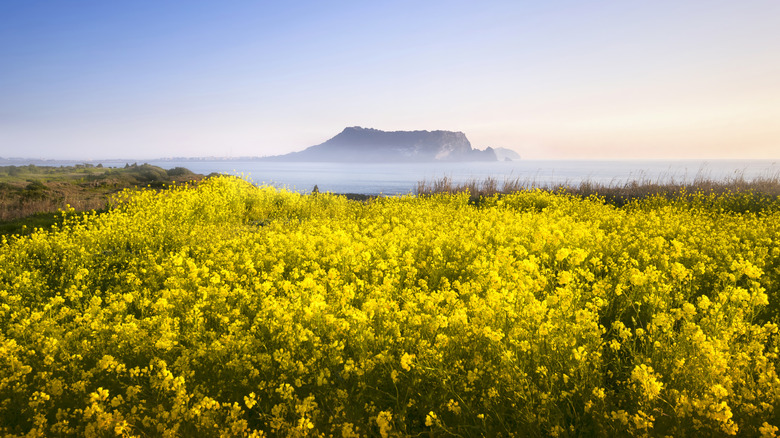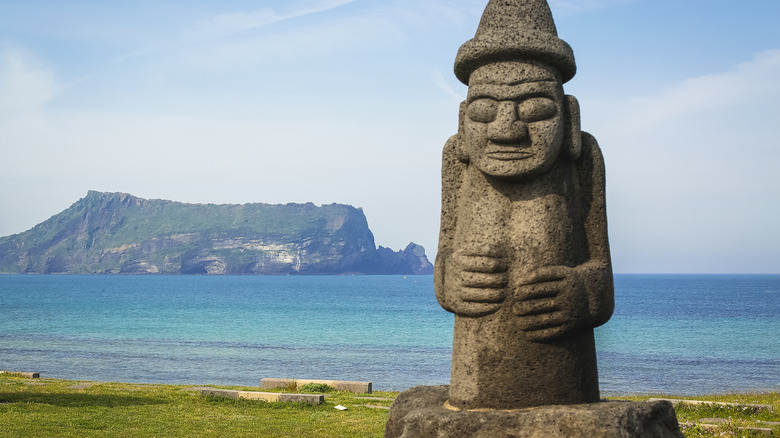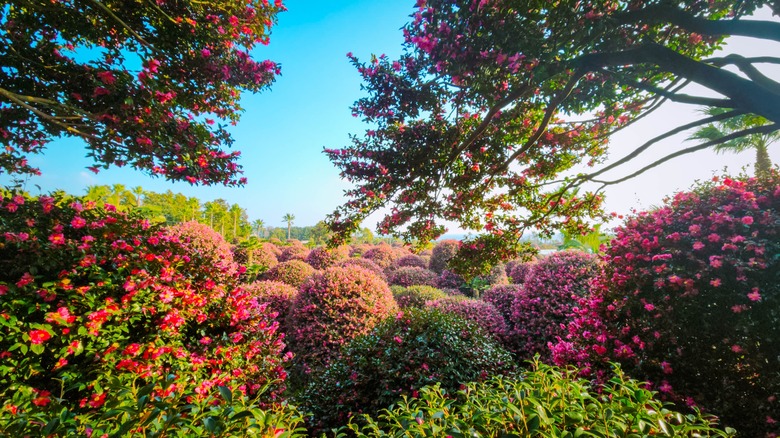This Mesmerizing Destination Is Easily South Korea's Most Beautiful Island Vacation
Often touted as the "Hawaii of South Korea," Jeju Island is a UNESCO World Heritage Site tucked off South Korea's southern shores. A vacation hotspot for Koreans and foreigners alike, Jeju was once a far flung isle that was rarely visited by outsiders but became a popular travel destination in the 1980s. Most well known now for its succulent tangerines, volcanic landscapes, and fresh seafood, Jeju is steeped in fascinating, and at times macabre, history.
The local dialect, known as Jejueo, has been designated a critically endangered language by UNESCO, many Jeju residents still believe in animism, and the famous female deep sea divers, called haenyeo, still swim into the depths of the sea to hunt for their families meals. Visitors can see all this and more on a trip to the island, whether they choose to seek out the many heritage sites like the Jeju Stone Park, or simply want to get back in touch with nature.
As the backdrop of countless K-dramas, from "Our Blues" to "Boys Over Flowers," you know that Jeju must be beautiful — and it is. Visitors will find sweeping vistas to explore, including the tallest peak in the entire country and a dormant volcano, Hallasan Mountain, alongside craggy cliff sides like Seongsan Ilchulbong. One thing's for sure, there's something for everyone on this temperate island paradise.
Best things to do on Jeju Island
For being such a small island, Jeju packs a punch with tons of things to do! Foodies will delight in the island's unique black pork, avid adventurers have a tangle of hiking trails to explore, and those seeking cultural experiences will be spoiled for choice.
Lovers of the great outdoors should head straight for Hallasan National Park, situated at the center of the island. Hop on the Seongpanak Trail if you're up for summiting this sleeping giant, or take an easier approach on the beautiful Yeongsil Trail. If hiking up volcanoes isn't your cup of tea, visitors can also opt to hike a section of the Jeju Olle Trail which circumnavigates the island in 271 miles. More outdoor adventures await at the Manjanggul Lava Caves, which offer a sneak peak at the island's volcanic past, and at the nearby Seongsan Ilchulbong, a towering tuff cone that overlooks the sea.
Although traces of Jeju's past are seemingly around every corner, visitors can go in search of heritage sites like the Jeju Stone Park. Stones are used in Jeju for everything from agricultural fences to the sacred dol hareubang, stone grandfathers that were carved from volcanic stone. You can also discover what life was like in Jeju over 100 years ago at the Jeju Folk Village. Many people flock to Jeju for food alone. Go in search of hallabong juice, freshly squeezed from Jeju tangerines, or the savory black pork that is often grilled much like traditional Korean BBQ. The Dongmun Public Market in Jeju City is a great place to find all of these specialties in one place.
How many days do you need on Jeju Island?
Four to five days is the perfect sweet spot for a trip to Jeju. Staying just shy of a full week will give you plenty of time to explore the nooks and crannies, from discovering the island's endless array of foodie treats to hiking and getting in some beach time.
With four days, visitors can easily see the largest town on the island, Jeju City, which is where most first-timers stay, and then move on to the surrounding sites in a clockwise or counterclockwise direction. Because Jeju is an oblong island with otherworldly landscapes and interesting sites scattered across it, you could also split up your overnights by staying in the southern city of Seogwipo. For those who decide to stay an extra day (for a total of five days), you'll also have time to visit the stunning Udo Island, nestled just off Jeju's eastern coast. Take the ferry and spend your day cycling around this little isle, discovering unique heritage and eating the famous peanut ice cream.
Despite being a fairly small island, it can take some time to get around Jeju. Most visitors opt to rent a car, which is one of the best ways to navigate between cities and the island's many natural features, but it's also possible to take public transportation. The public bus network is extensive, although it will take longer to get to your destination.


